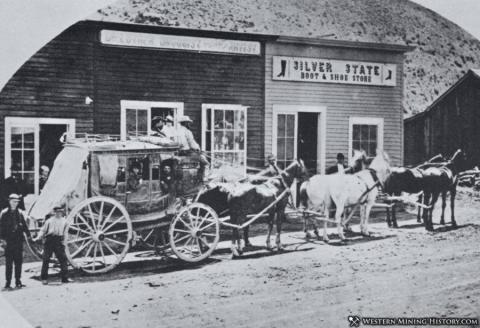Unionville is a small hamlet in Pershing County, Nevada, located south of I-80 and just west of State Route 400 on Unionville Road, with the most recent population estimate being approximately 20 people. The town's best years were during the 1870s, when it was an active mining and prospecting town serving the surrounding hilly region. For a brief time, Samuel Langhorne Clemens lived there and prospected, but left without having had much success. Currently, the hamlet consists of a single business – a tourist inn – and a few small houses clustered along or near the gravel roadway which permits vehicular ingress and egress. The nearest paved road, an extension of this gravel road, is about 7 miles to the east. The nearest services of any sort, other than those available at the inn, are approximately one hour's drive away.
Now in Pershing County, Unionville was the original county seat for Humboldt County, serving in that capacity from its founding in July 1861 until the seat was relocated to Winnemucca in 1873.[1] The big mining boom at Unionville occurred between 1863 and 1870. During that time, the population was reported to be as high as 1,500 persons. Mark Twain arrived in Unionville with the intention of prospecting for silver in 1862, describing the town as consisting of "eleven cabins and a liberty-pole". As is common in most mining communities, after the boom, the town experienced a decline soon afterwards. By 1870, it was discovered that there was little rich ore in the district. The decline was speeded by the completion of the Central Pacific Railroad through the Humboldt valley, and the establishment of Winnemucca as a major trading and shipping center.[2]
https://en.wikipedia.org/wiki/Unionville,_Nevada
184.14–19 Unionville consisted of eleven cabins . . . in the bottom of a crevice] Unionville, in the Buena Vista mining district, was laid out in July 1861 in a canyon in the Humboldt range, and in November became the Humboldt County seat. Although it apparently had only a handful of inhabitants when Clemens arrived in December 1861, by the following September the population was estimated at three hundred, and the town’s buildings—constructed of adobe, slate, brush, and canvas—lined the canyon for almost a mile. The area was reportedly “well stocked with liquor, lice and loafers; and [at] the same time is greatly in want of water power, wood and women” (“Nevada Territory,” Mining and Scientific Press 5 [14 June 62]: 5; L1, 151–52 n. 9; Laws 1862, 291; “Letter from the Humboldt Mines,” Sacramento Union, 6 May 62, 1; “The Humboldt Mining District,” San Francisco Alta California, 24 June 62, 1; Nomad, 1). Chapter 28: note for 184.14–19," in Roughing It : an electronic text. 2016
